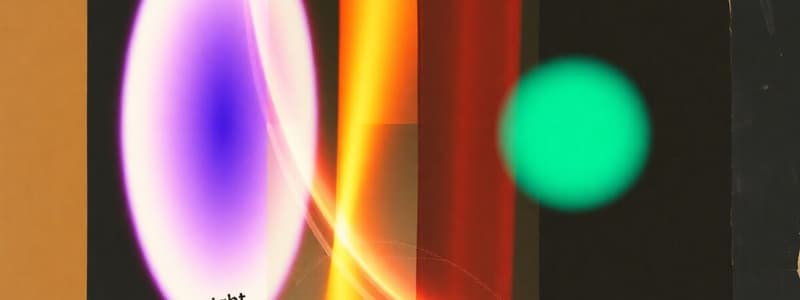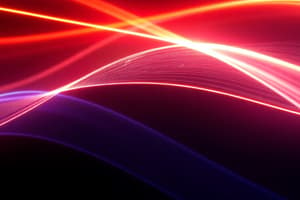Podcast
Questions and Answers
What happens to electrons when they absorb energy?
What happens to electrons when they absorb energy?
- They move to a lower energy level.
- They are ejected from the atom.
- They jump to a higher energy level. (correct)
- They release energy as heat.
What is the speed of light in a vacuum?
What is the speed of light in a vacuum?
- 300,000 km/sec (correct)
- 600,000 km/sec
- 450,000 km/sec
- 150,000 km/sec
Which of the following best describes the concept of refraction?
Which of the following best describes the concept of refraction?
- Bending of light due to a change in speed. (correct)
- Emission of light by hot objects.
- Reflection of light off a smooth surface.
- Absorption of light by a material.
What color is a completely opaque object that reflects red light?
What color is a completely opaque object that reflects red light?
What is the relationship between light frequency and wavelength?
What is the relationship between light frequency and wavelength?
Which of the following statements about transparent objects is correct?
Which of the following statements about transparent objects is correct?
What are photons?
What are photons?
In a primary rainbow, what color appears on the outer edge?
In a primary rainbow, what color appears on the outer edge?
Which colors are classified as primary colors of light?
Which colors are classified as primary colors of light?
What is the result of combining yellow and cyan pigments in digital media?
What is the result of combining yellow and cyan pigments in digital media?
What do rods in the retina primarily detect?
What do rods in the retina primarily detect?
Which of the following statements best describes color blindness?
Which of the following statements best describes color blindness?
According to the law of reflection, what is true about the angle of incidence and the angle of reflection?
According to the law of reflection, what is true about the angle of incidence and the angle of reflection?
What occurs during diffraction?
What occurs during diffraction?
What type of light is produced by heating an object until it glows?
What type of light is produced by heating an object until it glows?
Which secondary color is formed by mixing red and blue light?
Which secondary color is formed by mixing red and blue light?
Flashcards
Light Energy
Light Energy
The energy released when electrons in an atom move from a higher energy level to a lower level.
Photons
Photons
Tiny bundles or packets of energy released when electrons jump to lower energy levels in an atom.
Speed of Light in Vacuum
Speed of Light in Vacuum
Light travels at a constant speed in a vacuum, approximately 300,000 km/sec or 186,000 mi/sec.
Speed of Light in Materials
Speed of Light in Materials
Signup and view all the flashcards
Transverse Wave
Transverse Wave
Signup and view all the flashcards
Refraction
Refraction
Signup and view all the flashcards
Index of Refraction
Index of Refraction
Signup and view all the flashcards
Prism
Prism
Signup and view all the flashcards
Primary Colors of Light
Primary Colors of Light
Signup and view all the flashcards
Secondary Colors of Light
Secondary Colors of Light
Signup and view all the flashcards
Pigments
Pigments
Signup and view all the flashcards
Primary Pigments
Primary Pigments
Signup and view all the flashcards
Retina
Retina
Signup and view all the flashcards
Rods
Rods
Signup and view all the flashcards
Cones
Cones
Signup and view all the flashcards
Color Blindness
Color Blindness
Signup and view all the flashcards
Study Notes
Light Energy
- Light energy is released when electrons fall to a lower energy level.
- Atoms absorb energy, causing electrons to jump to a higher energy level.
- Photons are bundles/packets of energy released during electron transitions.
Electromagnetic Waves
- Light travels at 300,000 km/sec (or 186,000 mi/sec) in a vacuum.
- Light travels slower in materials like air, water, and glass.
Light as a Transverse Wave
- Light's energy is perpendicular to its direction of movement.
- Moving photons create electric and magnetic fields.
Electromagnetic Spectrum
- The visible spectrum is the portion of light we can see.
- The colors of visible light are arranged from longest to shortest wavelength: Roy G. Biv (Red, Orange, Yellow, Green, Blue, Indigo, Violet).
Refraction of Light
- Refraction is the bending of light due to a change in speed.
- The index of refraction indicates how much a material refracts light.
- Prisms bend light at different frequencies, separating it into different colors.
How We See
- The lens in our eye refracts light, focusing it onto the retina.
- Nerves transmit the image from the retina to the brain.
- Rods are nerve cells sensitive to light and dark.
- Cones are nerve cells that help us see color.
Color Blindness
- Approximately 8% of men and 0.5% of women experience color blindness.
- Color blindness is a problem with color receptors (cones). It causes an inability to distinguish certain colors, most notably red and green.
Reflection Diagram
- The incident beam is the light striking a mirror.
- The reflected beam is the light bouncing off a mirror.
- The normal is a line perpendicular to the mirror's surface.
- The angle of incidence equals the angle of reflection.
Law of Reflection
- The angle of incidence is equal to the angle of reflection.
Diffraction
- Diffraction is the bending of waves around the edge of a barrier.
- New waves are formed from the original, creating bands of light and dark colors.
Sources of Light
- Incandescent light is produced by heating an object until it glows.
- Fluorescent light is produced by electron bombardment of gas molecules. Phosphors absorb photons—created when mercury gas gets zapped with electrons—to produce light.
Optical Instruments
- Optical instruments include cameras, telescopes, microscopes, and lasers.
Lasers
-
Lasers are an acronym for Light Amplification by Stimulated Emission of Radiation
-
Lasers emit coherent light, meaning their waves are in phase. This makes them very powerful and intense, among many other uses.
-
Holography is a technique that uses lasers to create 3D images.
-
Fiber optics use light energy transmitted through long, flexible glass or plastic fibers. It's used in communications, medicine, television transmission, and data processing.
Color of Light
- White light is the combination of all colors in the visible spectrum.
- Black objects absorb all colors, reflecting none.
- Transparent objects transmit light without scattering. The transmitted color is the color seen.
- Translucent objects scatter and transmit some light.
- Opaque objects either reflect or absorb light. The reflected color is the color seen.
Color of Light (Primary Colors)
- Red, blue, and green are the primary colors of light. They can be combined to create any other color of light.
Color of Light (Additive Colors)
- Secondary colors are made by combining two primary colors. Magenta, cyan, and yellow are secondary colors of light.
Paint Pigments
- Paint pigments are colored substances that absorb or reflect light to give color to a substance.
- Red, yellow, and blue are the primary pigments.
- In digital media, mixing yellow, cyan, and magenta creates black.
- Pigments are subtractive; when different colors are combined, they absorb more light, resulting in darker colors.
Studying That Suits You
Use AI to generate personalized quizzes and flashcards to suit your learning preferences.




